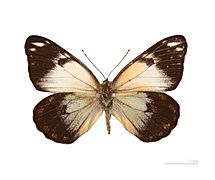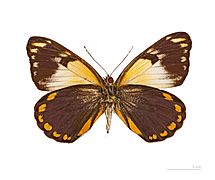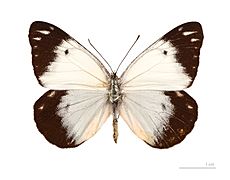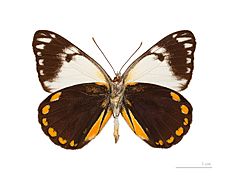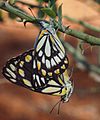Caper white facts for kids
Quick facts for kids Caper white |
|
|---|---|
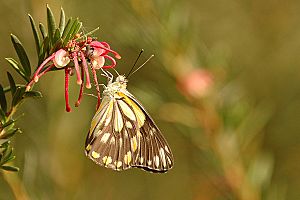 |
|
| Scientific classification | |
| Subspecies | |
| Synonyms | |
|
The Belenois java, also known as the caper white or common white, is a small butterfly. It belongs to the Pieridae family, which includes many white and yellow butterflies. You can find this butterfly in Australia, Indonesia, and Melanesia. Caper whites are known for flying long distances, meaning they are highly migratory. Sometimes, people confuse them with the cabbage white butterfly (Pieris rapae).
Contents
Identification
Adult Butterflies
Male Caper white butterflies have white wings. The top of their front wings has a wide black patch at the tip. Their back wings also have a black border. Both the front and back wings have white dots inside these black areas. The underside of the back wing is mostly black. However, it has white and yellow patches between the veins (the lines on the wings).
The male's wingspan is about 5 centimeters (2 inches). Female Caper whites are a bit larger, with a wingspan of about 6 centimeters (2.4 inches). Females can look very different from each other. Some pale females look a lot like the males. Generally, the top of the female's wings is white, but they have a much wider black edge. Both male and female butterflies have bodies that are olive green to dark brown.
- Both sexes and both sides - Muséum de Toulouse
Young Butterflies (Immature Stages)
The Caper white butterfly goes through several stages before becoming an adult.
Eggs
The eggs are small and orange. They are laid in groups on the top of the host plant's leaves.
Caterpillars (Larvae)
When the caterpillar first hatches (this is called the first instar), it is pale yellow. It has a few long hairs on its body. As the caterpillar grows, it becomes dark brownish-green. It develops raised white and yellow spots. Its head is shiny black and has a V-shaped white mark. Older caterpillars are about 3 centimeters (1.2 inches) long. They have two lines of hair along their sides.
Pupae
After the caterpillar is fully grown, it changes into a pupa. The pupa is white with black markings. It is about 2.5 centimeters (1 inch) long.
Life Cycle
Caper white butterflies lay their eggs in groups. They choose specific plants for their caterpillars to eat. These plants are called "host plants." Some of their favorite host plants include:
- Currant bush (Apophyllum anomalum)
- Scrub caper berry (Capparis arborea)
- Dog caper (Capparis canescens)
- Nipan (Capparis lasiantha)
- Australian native orange (Capparis mitchellii)
- Wild orange (Capparis sepiaria)
- Australian native caper (Capparis spinosa)
- Bush orange (Capparis umbonata)
Unlike some other caterpillars, the Caper white caterpillar does not eat a huge amount of food. This means they are less likely to cause problems for farms and crops. The caterpillars feed for about three weeks. After this, they are fully grown and change into pupae. The adult butterflies usually emerge from their pupal cases around December in most areas where they live.


